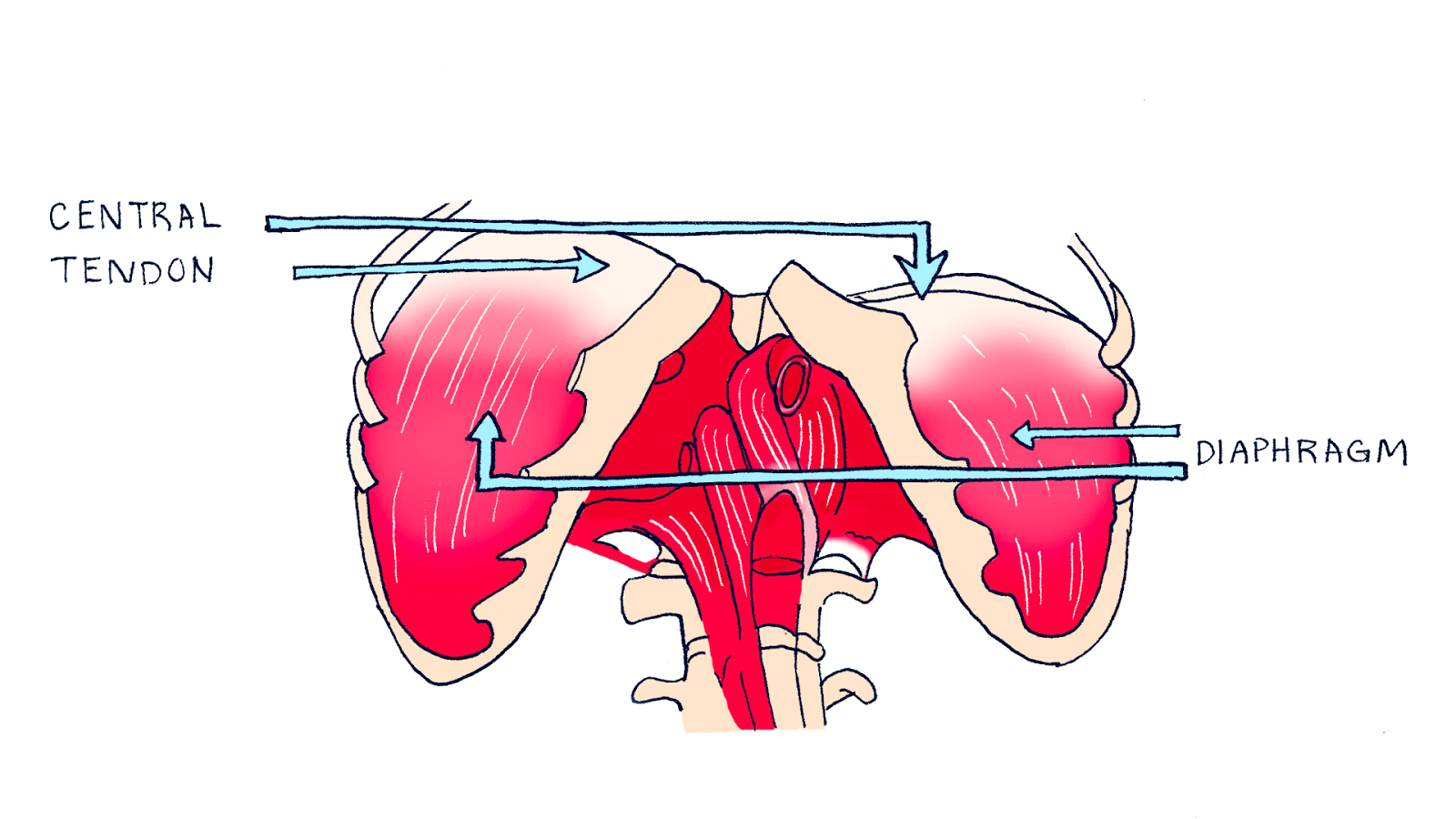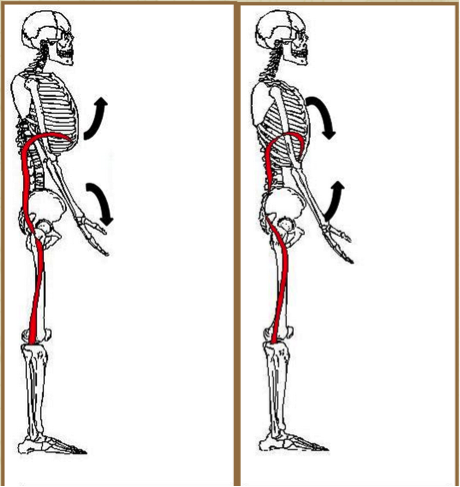Who would of thought one of the most asymmetrical muscles of our body has probably the most impact on us. From back problems, to posture, to our well being, our diaphragm in a way sets the tone of whats going on around us and has links to many different bodily systems. I’d like to dive in first on where exactly it is and some anatomical implications it has.
Its amazing and ironic that it is literally placed at the center of our body. You can’t get anymore center than our diaphragm. Its smack dab right at the bottom of our rib cage and underneath our lungs and in front of our spine. The diaphragm is almost like a septum that regulates airways and separates the chest cavity and abdominal cavity. From the front, the diaphragm has a sternal attachment right underneath the xiphoid process. The coastal fibers are along the inside of ribs 7 to 12. These ribs don’t attach to the sternum and are what we call the “bucket handle ribs” because when we inhale they expand out and up in a lateral direction. 
 Then from the back, the diaphragm attaches to the lumbar spine from the crural attachments.As you can see the right diaphragm leaflet has more attachments being from L1 all the way to L-3. If your curious to read more about how our body asymmetrical you can read this post. To truly bring this to light, that’s like half of all our lumber spine so it definitely has some say in whats going in our back and how much extension its contributing. Besides the crural attachments, there are the lumbocoastal ligaments which are the lateral, & medial arcuate ligaments. These ligaments connect the diaphragm to the lumbar spine kinda like a web and cross into muscles such as the Psoas & QL. And finally we have the central tendon of the diaphragm in the middle which is what plunges our diaphragm up and down in order to breath.
Then from the back, the diaphragm attaches to the lumbar spine from the crural attachments.As you can see the right diaphragm leaflet has more attachments being from L1 all the way to L-3. If your curious to read more about how our body asymmetrical you can read this post. To truly bring this to light, that’s like half of all our lumber spine so it definitely has some say in whats going in our back and how much extension its contributing. Besides the crural attachments, there are the lumbocoastal ligaments which are the lateral, & medial arcuate ligaments. These ligaments connect the diaphragm to the lumbar spine kinda like a web and cross into muscles such as the Psoas & QL. And finally we have the central tendon of the diaphragm in the middle which is what plunges our diaphragm up and down in order to breath. 
You can even see the central tendon on the right covers more space than on the left. Again, we are asymmetrical on the inside and that’s OK. Another cool thing about the natural asymmetry of our diaphragm is that there is depression in the middle right between the domes. That’s because the heart sits on top of it.


So the diaphragm has major influence on our heart rate and the Heart Rate Variability (HRV).
Besides making you wish the diaphragm dome should look symmetrical (but trust me we wouldn’t be the same if we were), the openings in the diaphragm itself gives way to important structures so things can go where they need to whether it’s above the diaphragm or below it.

Of the total openings, two are related to the heart such as the foramen of vena cava, and aortic hiatus and the final openning is the esophageal hiatus,. I can guess the things related to the heart make sense since the heart sits right above it but are you saying that the diaphragm has some kind of role in getting food down to our stomach? Yes! This Study suggests that the crural fibers act as a gastrointestinal sphincter helping food get to the stomach by the crural diaphragm briefly ceasing to contract. This will be so the bolus can transit across the diaphragm (Cherniack NS et al, 1984). So we have two openings related to the heart and a opening so food can go from the esophagus to the stomach via gastric reflux . It literally is the highway in the middle of our body.
So besides all this anatomy of where it’s located, why does the diaphragm have so much impact on us? Since it attaches to our rib cage and our spine, the position of those two landmarks are going to dictate what position the diaphragm is in as either a postural muscle or a respiratory muscle. In a way it almost owns us. We know its by the heart and our lungs but it also has a direct influence our autonomic system. Many of our sympathetic ganglia and nerves are in the ribacge and it can impinge on them if the ribcage is stuck in its position and can’t come back. From Gilbert C. Journal of Bodywork and movement Therapy, “We can easily disrupt the PH balance with 2 or 3 deep breaths. Ph will rise from 7.4 to 7.5 or CO2 will fall from a normal 40 to 30 or 25 in less with 30 seconds”. So with just the type of breathing we use we literally make ourselves Hypocapnic or have a decrease of Carbon Dioxide in our blood. This will raise our bodies PH and make us alkaline. Your basically hyperventillating and it’ll bring upon a bunch of sympathetic symptoms and unwanted things such as anxiety, hyper-arousal, and anything involving your sympathetic trunk making you feel like a tiger is chasing you.

If our diaphragm can’t do its job of going down and filling our lungs with air then our body is going to do it some way and will use accessory muscles to do it. This has major implications for our health and well being. But as humans we have a natural asymetrical bias of our right diaphragm. The leaflet on the right is already better as a respiratory muscle because it has support of the liver underneath and is bigger than the left. The left is in a tough spot because it is anatomically in a disadvantageous position because its smaller and also its pull is not advantageous as the right. Another big factor that we have to go a little further into depth are the ribs position and abdominals. As humans we really like our right side…..like a lot. We are going to be more neurologically orientated to the right and the right diaphragm, as we said before, is in a better position to breath. The right ribs are going to be internally rotated but our left ribs are usually going to be stuck in external rotation which will pull the coastal fibers of the diaphragm to descend in order to act as a postural muscle to stabilize you.

Also it will pull the lumbar spine forward via the crural attachments into a position of over extension. Understand that both attachment sites of the diaphragm, the back and sides, are putting our body into a precarious unstable position. Biomechanically the left ribs are stuck in an externally rotated position and the abdominals on the left side are lengthened becasue they can’t pull the ribs down in order to changing the left hemi rib position. The abdominals, specifically the Internal Obliques and Transverse Abdominals (Which I will just call abdominals for short to make life easier) act as a way for the ribcage to compress and internally rotate so it can be in a better position. It also forms what we call the Zone of Apposition, especially on the left side. which restores the position of the ribcage and in turn restores the position of the diaphragm to its fully ascended positioned.
The term “Appose” means “to be next to or adjacent to”. The diaphragm when its fully ascended will be apposed or next to literally everything. It’s next to the ribcage, the heart on top, and the organs underneath it. If you ever played basketball, this is your “Triple Threat Position”.

You can’t have good diaphragm positioning without good ribcage positioning. The ability for that left ribcage to fully depress, rotate in, and retract back will change the shape of the ribcage so its positioning can get the diaphragm back to its optimal dome position and now act as a breathing muscle. The diaphragm will ascend all the way up to our eighth ribcage (T-8) and now can be in a position to ease up on the sympathetic nerves and can actually go through its full excursion on the breath cycle.
This muscle has a massive influence in many of our bodily systems and it would be foolish to just isolate it by itself. Its contributing to everything whether we know it or not. I’ve learned to respect it and take it into account whether I’m training or helping others.
.
References
PRI-Postural Respiration Manual
https://www.ncbi.nlm.nih.gov/pubmed/12430954
https://physoc.onlinelibrary.wiley.com/doi/pdf/10.1113/jphysiol.1984.sp015139
https://www.ncbi.nlm.nih.gov/pmc/articles/PMC3731110/

